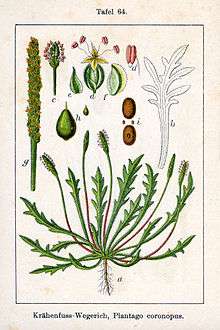Plantago coronopus
| Plantago coronopus | |
|---|---|
 | |
| Scientific classification | |
| Kingdom: | Plantae |
| (unranked): | Angiosperms |
| (unranked): | Eudicots |
| (unranked): | Asterids |
| Order: | Lamiales |
| Family: | Plantaginaceae |
| Genus: | Plantago |
| Species: | P. coronopus |
| Binomial name | |
| Plantago coronopus L. | |
| Synonyms[1] | |
| |
Plantago coronopus (known as buck's-horn plantain,[2] minutina or erba stella) is a herbaceous annual to perennial flowering plant in the family Plantaginaceae.
Description
Plantago coronopus produces a basal rosette of narrowly lance-shaped leaves up to 25 centimeters long that are toothed or deeply divided. The inflorescences grow erect to about 4 to 7 cm in height. They have dense spikes of flowers which sometimes curve. Each flower has four whitish lobes each measuring about a millimeter long. Plantago coronopus mainly grows on sandy or gravelly soils close to the sea. It is native to Eurasia and North Africa but it can be found elsewhere, including the United States, Australia, and New Zealand as an introduced species.
It is sometimes grown as a leaf vegetable known as erba stella,[3] mostly incorporated in salad mixes for specialty markets. Recently it has become popular as a frost-hardy winter crop for farmers in northern climates, and is usually grown in unheated hightunnels.
References
- ↑ The Plant List: A Working List of All Plant Species, retrieved 4 March 2016
- ↑ "BSBI List 2007" (xls). Botanical Society of Britain and Ireland. Retrieved 2014-10-17.
- ↑ Coleman, E. (1999), Four-Season Harvest: Organic Vegetables from Your Home Garden All Year Long (second ed.), Chelsea Green Publishing, ISBN 978-1890132279
External links
| Wikimedia Commons has media related to Plantago coronopus. |
